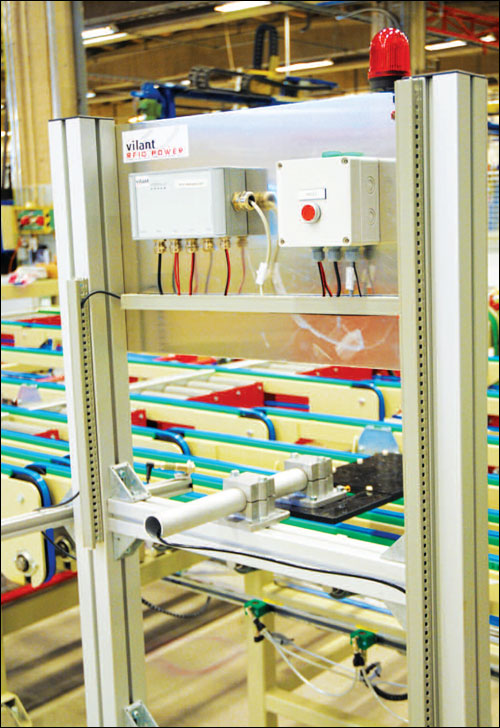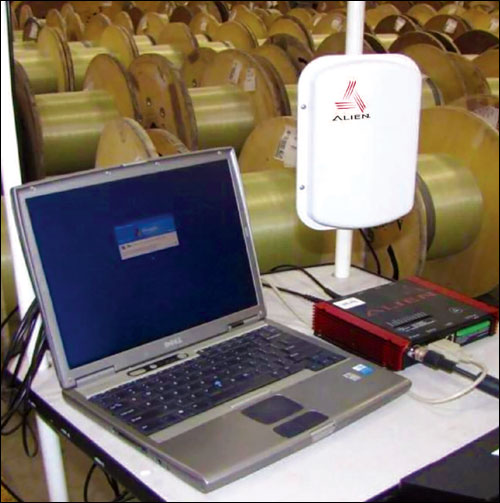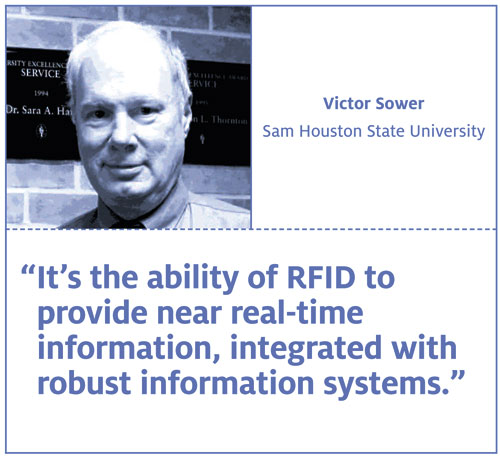Oct 01, 2012If you've visited Finland or other Nordic countries, there is a good chance you've looked out a window or opened a door manufactured by Fenestra Oy. The company produces more than half a million windows and doors each year, and for the past six years, it has been using radio frequency identification technology as part of a major automation initiative that enabled its transition to a make-to-order manufacturing process. Rather than stocking standard windows, the company now makes custom products, quickly and efficiently, to better meet customers' requirements.
"It is easy to say that we are glad we chose RFID to automate the manufacturing process," says Kari Lahti, Fenestra's production manager.

Before Fenestra adopted an RFID work-in-process (WIP) application, workers had to manually confirm each component's specifications before the part was processed. Now, RFID tags attached to individual components, such as window frames and sashes, are identified by an infrastructure of more than 50 RFID readers integrated throughout the production lines at Fenestra's manufacturing plant. Each tag is encoded with a unique identifier that references, in Fenestra's enterprise software, the specific order for which the window or door is being made. This triggers the machine to cut, drill, paint or otherwise process the component to the order's exact specifications.
The RFID system consumes 1.5 million high-frequency passive RFID tags annually. The tags are read 20 million times throughout the process. They have a virtually 100 percent accurate read rate, and are durable enough to withstand the high temperatures, pressures and vibrations the components experience during manufacturing.
"Without RFID, Fenestra would have had difficulties in building an automatic make-to-order manufacturing plant," says Ville Kauppinen, CEO of Vilant, the Finnish RFID systems integrator that developed the WIP solution. "The whole plant was rebuilt and automated, largely to enable RFID. The main benefit was full automation and a significant increase in efficiency and lessened need of manpower."
In the United States, for example, a recent survey—part of an eight-year study by researchers at Sam Houston State University (SHSU) and Southern Arkansas University—revealed a significant increase in the number of surveyed firms that use RFID for a range of applications, including tracking raw materials, WIP and finished products.
"It's the ability of RFID to provide near real-time information, integrated with robust information systems," says Victor Sower, a professor of operations management at SHSU and one of the researchers. RFID has enabled supply-chain visibility, more efficient operations and better outcomes for just-in-time manufacturing systems, he adds, which helps companies that invest in the technology be "more agile, more effective."
The growing use of RFID in manufacturing also can be attributed to the steady rise in the quality and capability of RFID technology. "RFID technology has a lot going for it right now, particularly in the manufacturing environment, where you need standards-backed technology," says Michael Liard, RFID analysis director at VDC Research. "You need the technology to work in a harsh environment, which many manufacturing hubs are. A few years ago, passive UHF wasn't ready for prime time, and now it's at its highest point in terms of technology innovation and development. So it can serve these previously underserved markets, with viable, scalable solutions that can be done in a cost-effective manner."
In fact, Sower, Liard and end users agree that to get the most value from RFID technology, manufacturers should consider standards and scalable solutions.
Sumitomo Electric Lightwave, a North Carolina manufacturer of fiber-optic cables, began exploring RFID about five years ago, because it wanted to automate inventory tracking in its warehouse. The company had been relying on its employees to faithfully scan the bar codes on raw materials, but they often failed to do so, says Cosby Dudley, the company's production planning manager.
In 2009, Sumitomo Electric deployed an inventory-management system, developed by Mid-South Marking Systems. It uses EPC Gen 2 ultrahigh-frequency tags to track a wide range of raw materials, such as steel tape reels, Kevlar yarns and boxes of plastic materials, from the warehouse to the manufacturing area.
Today, the company's inventory of raw materials is significantly more accurate, Dudley says. "We meet every week to review the inventory levels in our ERP system, and it tells us what [raw materials] to buy, based on present inventory levels," he says. "We used to leave the meeting and go down and count stuff manually, because we didn't trust the data in the ERP."
The company also worked with Mid-South Marking Systems to expand its use of RFID. In 2011, it developed a mobile RFID reader cart to perform regular cycle counts to check portions of its inventory. The company had still been performing its twice-annual full inventory counts of the entire warehouse manually, Dudley says, because he didn't feel completely confident in the cart reader's ability to capture all the RFID tags. After the cart was used to perform a mid-year full inventory in June, an audit revealed that the RFID-based inventory count was more accurate than previous counts conducted manually. "It works great," Dudley says.
Since adopting RFID, Sumitomo Electric has been growing its business. It now produces 40 percent more product annually than before it deployed the technology. But thanks to the inventory-tracking system, it has not had to hire additional warehouse employees. In addition, the RFID system has allowed Dudley to decrease the amount of raw materials inventory he has on hand at any time. This lowers the company's costs and moves it toward a lean, just-in-time manufacturing system, he says, because the company is confident it has all the needed raw materials at the right time and correct place.
Manufacturers are using RFID to automatically track WIP to solve a variety of problems, many stemming from manual production and human errors. For Fenestra, it ensures the correct components are processed to exact specifications. It also creates a standard and predictable pace of production, so the company knows how many products it will make in a given time period.
Hewlett-Packard Brazil deployed an RFID WIP system in 2006 to analyze the processes used to manufacture and distribute printers. The company has been able to decrease downtime on its manufacturing lines, reduce its printer inventory in the supply chain and move closer to perfect order fulfillment.

In 2010, German heating technology manufacturer Vaillant Group adopted an RFID WIP system to prevent errors in the assembly of residential boilers that would go undetected until the product was tested.
Each boiler is assembled on a wheeled cart, which a worker pushes from one assembly station to the next (there are 15 stations in total) in a precise order. An RFID reader mounted at each station collects the unique identifier encoded to the battery-assisted passive UHF EPC Gen 2 RFID tag attached to each cart. In the back-end software, the RFID number is coupled with the serial number of the boiler being produced. If a worker brings a cart to a station out of sequence, that station's machinery will stop, preventing the worker from further assembling the boiler.
The WIP system generates an ongoing, electronic register of all the boilers being manufactured at any time throughout the plant. This gives plant managers a quick, accurate overview of the production system, and helps them keep the entire system running smoothly.
Vaillant Group first deployed the WIP system on one assembly line at its U.K. plant in Belper, Derbyshire. When that proved successful—it reduced production errors six-fold, the company reports—the system was expanded to the other three assembly lines in that factory. Today, a total of 16 assembly lines, in France, Germany, Slovakia and the United Kingdom, use RFID to track WIP in the production of residential boilers.
The RFID system has been very successful, says Harald Brokamp, who manages Vaillant Group's test and assembly systems. It provides visibility into the manufacturing process that was previously unattainable, he says, and gives managers new tools for supporting manufacturing workers.
RFID also can be a valuable tool after a finished product leaves a factory or warehouse. In 2011, HP Brazil began leveraging the RFID information in its tagged ink-jet printers to facilitate the recycling of plastics. "The great part is that RFID tags are still alive from five to six years ago," says Marcelo Pandini, HP Brazil's country operations manager.
In 2009, the Indian government set an aggressive goal to increase the amount of energy generated via solar power and to make the energy source cost-competitive with other types of generation by 2022. The government also mandated that each solar—or photovoltaic (PV)—module placed into use must carry an RFID tag, so it can be easily identified and tracked throughout its useful life. The objective is to link PV module manufacturers to solar power deployments—which, in some cases, contain many hundreds of modules.
PV manufacturers are taking different approaches to meeting this requirement. Some are embedding RFID tags directly into the solar module during the manufacturing process, while others are attaching tags externally.
Either way, the power companies that purchase the modules—and the government agents who will inspect them periodically—will be able to quickly access information by reading a module's RFID tag, to determine whether panels are operating at peak performance, and to locate and replace modules that are outdated or recalled. The tags also will provide an efficient and accurate method for tracking modules that must be removed from installations for repair.
Waaree, a Mumbai-based solar module manufacturer, deployed an RFID system that not only complies with the government mandate but also provides a number of internal benefits. The company is tagging PV modules at its manufacturing plant, rather than at a later point along the supply chain, such as at a distribution center, to maximize the technology's benefits, including greater inventory visibility and management, improved manufacturing and shipping efficiencies, and reduced inventory levels.
But the RFID system's value extends beyond asset tracking. It facilitates compliance with government regulations to inspect cylinders every five years. It also enables Swire to automatically monitor when containers require maintenance and cull those that have expired. And, in the event of a product recall, the company can collect only the containers that carry recalled product, rather than all of those in circulation, which it had to do in the past due to its inability to identify cylinders individually.
The Enterprise Approach
The challenge for manufacturers as they consider RFID is to start small but think big. To derive as much value from the technology as possible, manufacturers need to avoid taking a "parochial view" of how and where RFID should be used, Sower says. Instead, they need to look across many departments for potential applications.
"People tend to have a laser focus and might want to start with one application, where they use RFID as a form of wireless auto-ID," Liard says. "That's great, because it's getting them, as an organization, comfortable using RFID." But, he says, manufacturers should continue to look for ways to exploit RFID technology. "You might start with tagging parts on the assembly line, but do you want to track workers and make sure workflows are improving? Do you want to track certain bins of tools? What can you layer on the initial applications? I think that is something the vendor community and systems integrator community need to work on quite aggressively."
Standard technology and business practices have enabled Deere & Co., one of the world's largest manufacturers of agricultural and construction equipment, to deploy an RFID asset-tracking solution in 2005—and, in 2007, roughly a dozen RFID systems in factories and warehouses, as well as put in place the infrastructure to readily expand the use of RFID into new areas when the need arises. The company says its ultimate goal is to use RFID to provide end-to-end visibility in the value chain.
When Cosby Dudley, production planning manager for Sumitomo Electric Lightwave, began exploring RFID, he found vendor expertise and tag performance lacking, to put it politely. The North Carolina manufacturer of fiber-optic cables wanted a tool to automate inventory tracking in its warehouse.
"We were stunned," Dudley says. "This was probably four or five years ago, but we got some just outrageous proposals [from perspective vendors]. I would say what we wanted, and they'd come back with $10,000 proposals—just to test the warehouse to see if the technology would work. My response was, 'This either works or it doesn't.'"
Mid-South Marking Systems, a solution provider in Memphis, Tenn., agreed to work with Sumitomo Electric, providing the equipment and software needed to develop a system, free of charge. The trial led to a permanent solution, in 2009.
"In my opinion, a good partner is someone who is going to help you up front without spending a lot of money," Dudley says. "I would also suggest end users educate themselves as much as possible about RFID and its capabilities. Attending RFID Journal LIVE! in Florida in 2011 was a real eye-opener. I wished I had done that in 2008 or 2009, when we were trying to learn about RFID by reading online articles and sitting through webinars. Those were good, but not nearly as good as the demonstrations one gets at the RFID expo."
It's essential for end users to align themselves with RFID experts who understand their specific business requirements and potential benefits, says Michael Liard, RFID analysis director at VDC Research. "End users prefer to work with vendors who understand their industry-specific needs, wants and goals."



